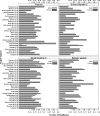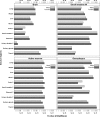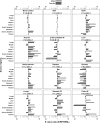S values for 131I based on the ICRP adult voxel phantoms
- PMID: 25829162
- PMCID: PMC4729327
- DOI: 10.1093/rpd/ncv016
S values for 131I based on the ICRP adult voxel phantoms
Abstract
To improve the estimates of organ doses from nuclear medicine procedures using (131)I, the authors calculated a comprehensive set of (131)I S values, defined as absorbed doses in target tissues per unit of nuclear transition in source regions, for different source and target combinations. The authors used the latest reference adult male and female voxel phantoms published by the International Commission on Radiological Protection (ICRP Publication 110) and the (131)I photon and electron spectra from the ICRP Publication 107 to perform Monte Carlo radiation transport calculations using MCNPX2.7 to compute the S values. For each phantom, the authors simulated 55 source regions with an assumed uniform distribution of (131)I. They computed the S values for 42 target tissues directly, without calculating specific absorbed fractions. From these calculations, the authors derived a comprehensive set of S values for (131)I for 55 source regions and 42 target tissues in the ICRP male and female voxel phantoms. Compared with the stylised phantoms from Oak Ridge National Laboratory (ORNL) that consist of 22 source regions and 24 target regions, the new data set includes 1662 additional S values corresponding to additional combinations of source-target tissues that are not available in the stylised phantoms. In a comparison of S values derived from the ICRP and ORNL phantoms, the authors found that the S values to the radiosensitive tissues in the ICRP phantoms were 1.1 (median, female) and 1.3 (median, male) times greater than the values based on the ORNL phantoms. However, for several source-target pairs, the difference was up to 10-fold. The new set of S values can be applied prospectively or retrospectively to the calculation of radiation doses in adults internally exposed to (131)I, including nuclear medicine patients treated for thyroid cancer or hyperthyroidism.
Published by Oxford University Press 2015. This work is written by (a) US Government employee(s) and is in the public domain in the US.
Figures





Similar articles
-
Comparison of internal dosimetry factors for three classes of adult computational phantoms with emphasis on I-131 in the thyroid.Phys Med Biol. 2011 Nov 21;56(22):7317-35. doi: 10.1088/0031-9155/56/22/020. Phys Med Biol. 2011. PMID: 22040775 Free PMC article.
-
Impact on 141Ce, 144Ce, 95Zr, and 90Sr beta emitter dose coefficients of photon and electron SAFs calculated with ICRP/ICRU reference adult voxel computational phantoms.Health Phys. 2010 Oct;99(4):503-10. doi: 10.1097/HP.0b013e3181c479bf. Health Phys. 2010. PMID: 20838091
-
Assessment of S values for I131 and Y90 based on the Digimouse voxel phantom.J Cancer Res Ther. 2018 Oct-Dec;14(6):1298-1302. doi: 10.4103/0973-1482.191058. J Cancer Res Ther. 2018. PMID: 30488847
-
Overview of the ICRP/ICRU adult reference computational phantoms and dose conversion coefficients for external idealised exposures.Radiat Prot Dosimetry. 2014 Oct;161(1-4):11-6. doi: 10.1093/rpd/nct304. Epub 2013 Nov 26. Radiat Prot Dosimetry. 2014. PMID: 24285286 Review.
-
Dose, dose, dose, but where is the patient dose?Radiat Prot Dosimetry. 2024 Jun 22;200(10):945-955. doi: 10.1093/rpd/ncae137. Radiat Prot Dosimetry. 2024. PMID: 38847407 Review.
Cited by
-
Red bone marrow dose estimation using several internal dosimetry models for prospective dosimetry-oriented radioiodine therapy.Radiat Environ Biophys. 2018 Nov;57(4):395-404. doi: 10.1007/s00411-018-0757-2. Epub 2018 Oct 8. Radiat Environ Biophys. 2018. PMID: 30298289
-
Estimated Organ Doses to Patients from Diagnostic Nuclear Medicine Examinations over Five Decades: 1960-2010.Health Phys. 2017 Dec;113(6):474-518. doi: 10.1097/HP.0000000000000721. Health Phys. 2017. PMID: 28968348 Free PMC article.
-
Dose Coefficients for Internal Dose Assessments for Exposure to Radioactive Fallout.Health Phys. 2022 Jan 1;122(1):125-235. doi: 10.1097/HP.0000000000001500. Health Phys. 2022. PMID: 34898518 Free PMC article.
-
S VALUES FOR NEUROIMAGING PROCEDURES ON KOREAN PEDIATRIC AND ADULT HEAD COMPUTATIONAL PHANTOMS.Radiat Prot Dosimetry. 2019 Dec 23;185(2):168-175. doi: 10.1093/rpd/ncy287. Radiat Prot Dosimetry. 2019. PMID: 30864663 Free PMC article.
-
INVESTIGATION OF THE INFLUENCE OF THYROID LOCATION ON IODINE-131 S VALUES.Radiat Prot Dosimetry. 2020 Jul 13;189(2):163-171. doi: 10.1093/rpd/ncaa027. Radiat Prot Dosimetry. 2020. PMID: 32285115 Free PMC article.
References
-
- Beierwaltes W. H., Rabbani R., Dmuchowski C., Lloyd R. V., Eyre P., Mallette S. An analysis of “ablation of thyroid remnants” with I-131 in 511 patients from 1947–1984: experience at University of Michigan. J. Nucl. Med. 25, 1287–1293 (1984). - PubMed
-
- Meier D. A., Brill D. R., Becker D. V., Clarke S. E. M., Silberstein E. B., Royal H. D., Balon H. R. Procedure guideline for therapy of thyroid disease with (131)iodine. J. Nucl. Med. 43, 856–861 (2002). - PubMed
-
- Ron E., et al. Cancer mortality following treatment for adult hyperthyroidism. J. Am. Med. Assoc. 280, 347–355 (1998). - PubMed
-
- Willegaignon J., Stabin M. G., Guimaraes M. I., Malvestiti L. F., Sapienza M. T., Maroni M., Sordi G. M. Evaluation of the potential absorbed doses from patients based on whole-body 131I clearance in thyroid cancer therapy. Health Phys. 91, 123–127 (2006). - PubMed
-
- Smith T., Edmonds C. J. Radiation dosimetry in the treatment of thyroid carcinoma by I-131. Radiat. Prot. Dosim. 5, 141–149 (1983).
Publication types
MeSH terms
Substances
Grants and funding
LinkOut - more resources
Full Text Sources
Other Literature Sources

